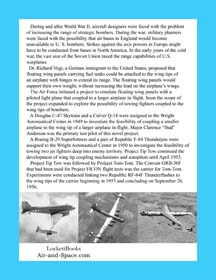Flying Aircraft Carriers of the USAF:
Wing Tip Coupling: C-47A/Q-14
|
In 1949, the Air Force evaluated wing tip coupling with a Douglas C-47 Skytrain and a Culver Q-14 Cadet at the Wright Air Development Center at Wright Field in Ohio. Theory predicted that increasing the aspect ratio of an airplane wing by attaching another wing at its tip improved aeodynamic efficiency, offsetting the drag of the smaller plane. A bomber would be able to tow a fighter into a combat zone with little loss of range.
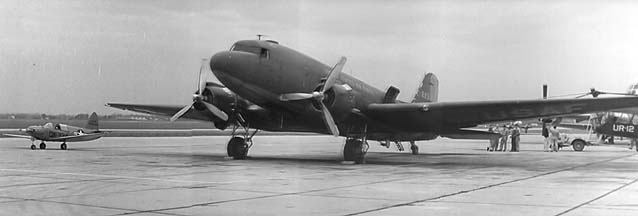 The Culver Q-14B Cadet was a single-place general aviation ariplane that the Army adopted for use as a radio controlled drone. The little drone still had a cockpit and flight controls. It was painted bright red. (Still frames from US Air Force film 14425 Investigation of Aircraft in Coupled Flight)
The Culver Q-14B Cadet was a single-place general aviation ariplane that the Army adopted for use as a radio controlled drone. The little drone still had a cockpit and flight controls. It was painted bright red. (Still frames from US Air Force film 14425 Investigation of Aircraft in Coupled Flight)
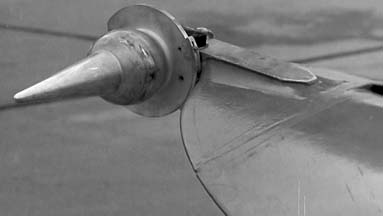 A lance with a ball joint was installed on the left wing of Q-14B 44-68334. The lance pointed to the rear. (Still frame from Investigation of Aircraft in Coupled Flight)
A lance with a ball joint was installed on the left wing of Q-14B 44-68334. The lance pointed to the rear. (Still frame from Investigation of Aircraft in Coupled Flight)
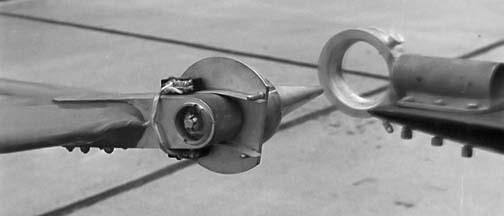 A matching ring was installed on the right wing of EC-47A 42-23918. (Still frame from Investigation of Aircraft in Coupled Flight)
A matching ring was installed on the right wing of EC-47A 42-23918. (Still frame from Investigation of Aircraft in Coupled Flight)
 Major Clrence E. "bud" Anderson flew the initial wing tip coupling tests in August 1949.(Bud Anderson)
Major Clrence E. "bud" Anderson flew the initial wing tip coupling tests in August 1949.(Bud Anderson)
 Bud Anderson is a WWII Triple Ace who flew the P-51 Mustang, "Old Crow" while assigned to the 357th Fighter Group "Yoxford Boys", 8th Air Force, Leiston Field, United Kingdom. Visit the Clarence E. "Bud" Anderson web site. I highly recommend buying and reading a copy of his book, To Fly and Fight. It contains his first person accounts of the early FICON test flights.
Bud Anderson is a WWII Triple Ace who flew the P-51 Mustang, "Old Crow" while assigned to the 357th Fighter Group "Yoxford Boys", 8th Air Force, Leiston Field, United Kingdom. Visit the Clarence E. "Bud" Anderson web site. I highly recommend buying and reading a copy of his book, To Fly and Fight. It contains his first person accounts of the early FICON test flights.
 Additional pilots joined the project in December 1949. (Bud Anderson)
Additional pilots joined the project in December 1949. (Bud Anderson)
 Seventeen pilots experimented with Q-14B wing tip coupling. Some advneturous pilots evaluated a rear entry technique with the lance facing forward. (Bud Anderson)
Seventeen pilots experimented with Q-14B wing tip coupling. Some advneturous pilots evaluated a rear entry technique with the lance facing forward. (Bud Anderson)
 Wing tip coupling evaluations continued through 1951. Despite some awkward separations, there were no significant incidents. (Bud Anderson)
Wing tip coupling evaluations continued through 1951. Despite some awkward separations, there were no significant incidents. (Bud Anderson)
-advertisement -
- advertisement -
Wing Tip Coupling
2020 calendar
You can buy a 2020 calendar
featuring photographs of Air Force projects investigating the coupling of smaller airplanes to larger airplanes' wing tips.
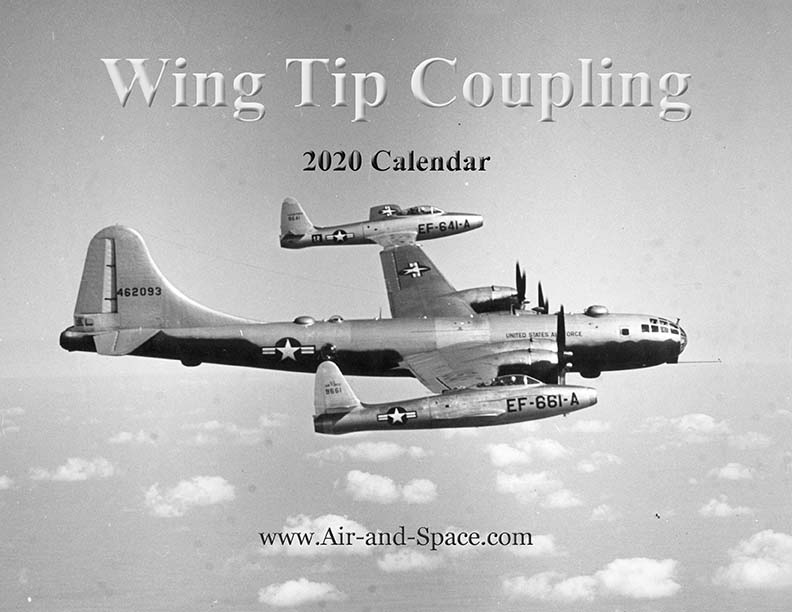
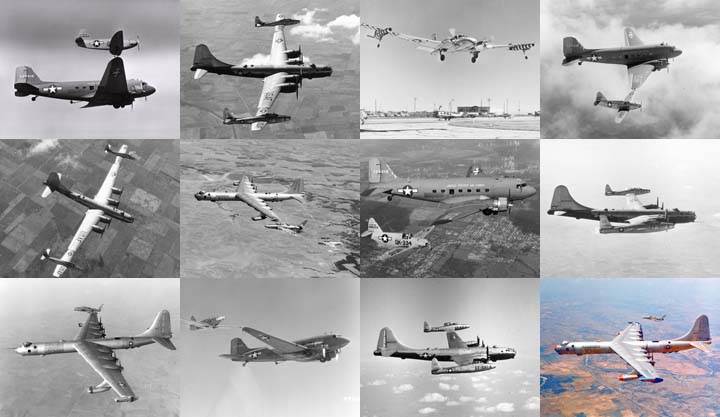
In the early years of the cold war, the US Air Force attempted to increase the range of airplanes by carrying fuel in hinged wing panels that supported themselves attached to their wing tips. The initial tests used a piloted light plane to simulate the hinged panels. Soon the scope of the experiments expanded to include towing a pair of jet fighters on the wing tips of a giant bomber. Photo sources: Bud Anderson, Air Force, General Dynamics, Lockheed-Martin:
Douglas C-47A 42-23918 and Culver Q-14B 44-68334
Project Tip-Tow: Boeing EB-29A 44-62093 and Republic EF-84D Thunderjets 48-0641 and 48-0661
Project Long Tom: Beechcraft XL-23C
Project Tom-Tom: Convair JRB-36F 49-2707 and Republic RF-84F Thunderflashes 51-1848 and 51-1849
 Put a copy of the Wing Tip Coupling: 2020 calendar in your Lulu.com shopping cart for $14.95.
Put a copy of the Wing Tip Coupling: 2020 calendar in your Lulu.com shopping cart for $14.95.
- advertisement -
Other Flying Aircraft Carriers of the USAF
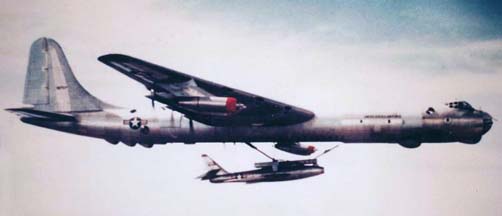 Flying Aircraft Carriers of the USAF
Flying Aircraft Carriers of the USAF
Go to the home page of the Goleta Air
and Space Museum. 
Send a message to Brian.
 The Culver Q-14B Cadet was a single-place general aviation ariplane that the Army adopted for use as a radio controlled drone. The little drone still had a cockpit and flight controls. It was painted bright red. (Still frames from US Air Force film 14425 Investigation of Aircraft in Coupled Flight)
The Culver Q-14B Cadet was a single-place general aviation ariplane that the Army adopted for use as a radio controlled drone. The little drone still had a cockpit and flight controls. It was painted bright red. (Still frames from US Air Force film 14425 Investigation of Aircraft in Coupled Flight)



 Bud Anderson is a WWII Triple Ace who flew the P-51 Mustang, "Old Crow" while assigned to the 357th Fighter Group "Yoxford Boys", 8th Air Force, Leiston Field, United Kingdom. Visit the Clarence E. "Bud" Anderson web site. I highly recommend buying and reading a copy of his book, To Fly and Fight. It contains his first person accounts of the early FICON test flights.
Bud Anderson is a WWII Triple Ace who flew the P-51 Mustang, "Old Crow" while assigned to the 357th Fighter Group "Yoxford Boys", 8th Air Force, Leiston Field, United Kingdom. Visit the Clarence E. "Bud" Anderson web site. I highly recommend buying and reading a copy of his book, To Fly and Fight. It contains his first person accounts of the early FICON test flights. 



